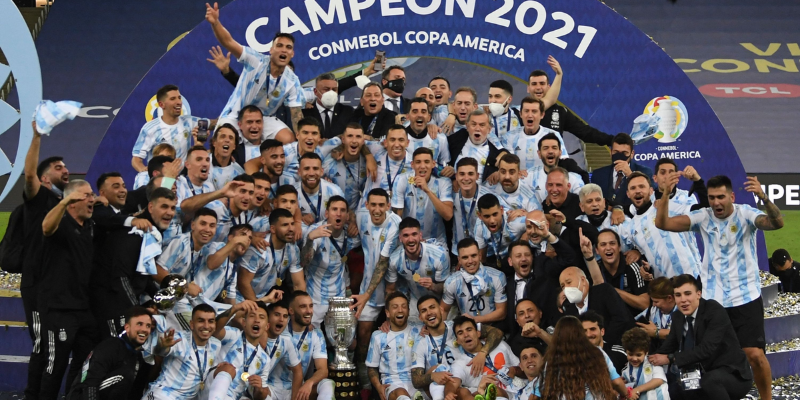In the rich tapestry of South American football, the first Copa America champion holds a special place in history. It was a moment when football in the continent declared itself official, a moment that still resonates among fans of Uruguay, Argentina, Brazil, and all South American football lovers. In this article, DeutKick will take you on a journey back to 1916 — uncovering how the tournament began, how the first champion was crowned, and why that victory still matters today.
The Birth of Copa América: Origins and Significance

The competition we know today as the Copa América was not always called that. In 1916, the tournament was launched under the name South American Football Championship (Campeonato Sudamericano de Football), to commemorate the centenary of Argentina’s independence and to celebrate the continent’s footballing potential., it would eventually be renamed “Copa América” in 1975, but its roots stretch back to those early years of fierce rivalry and pioneering spirit.
The inaugural tournament stood as a symbolic assertion: South American nations would not simply play friendlies — they would compete for more. It became the oldest continental international football competition in the world, a crown that adds prestige to every trophy since.
The 1916 Tournament: Format, Teams, and Key Moments

The 1916 South American Championship took place in Buenos Aires and Avellaneda, Argentina, between July 2 and July 17. The format was simple and brutal: a single round-robin involving four teams — Argentina, Brazil, Chile, and Uruguay.
Each team played the other once. Points were awarded with the then-standard system: two points for a win, one for a draw, and zero for defeat. The team with the highest points at the end would be champion — no playoffs, no finals.
Key Matches and Turning Points
- Uruguay vs. Chile: The opening match saw Uruguay trounce Chile 4–0. It was a declaration of intent.
- Uruguay vs. Brazil: A 2–1 win over Brazil cemented Uruguay’s strong position.
- Argentina vs. Uruguay: The decisive clash, played under dramatic conditions, ended 0–0. This draw was enough for Uruguay to edge ahead in points and clinch the title.
One interesting incident: the first match between Argentina and Uruguay, originally held at GEBA stadium, was abandoned just 5 minutes in due to a spectator riot. The match was voided and later replayed at a different venue (Racing Club). That replay ended 0–0 and became the match that sealed Uruguay’s inaugural crown.
At the end, Uruguay tallied 5 points (2 wins, 1 draw), finishing top of the table. Argentina came second with 4 points, Brazil third with 2, and Chile last with 1.
Thus, Uruguay was crowned the first-ever continental champion in South America — the first Copa America champion in spirit, even though at that time the name had not yet been adopted.
Uruguay: The First Champion and Their Legacy

By becoming the initial champions, Uruguay launched what would become a golden football tradition. That 1916 victory was more than just a title — it was a milestone in international football history.
Uruguay’s Strength in Early Years
- Uruguay defended their title in 1917, hosted at home in Montevideo, and won it again.
- In the decades following, Uruguay would frequently assert dominance in the South American Championship / Copa América.
- Some legendary players emerged in that era — names like Héctor Scarone, whose contributions to Uruguay’s early successes became part of national lore.
Their early victories laid the cultural and sporting groundwork for Uruguay’s later international success — including Olympic golds in 1924 and 1928, and World Cups in 1930 and 1950.
Why That Title Still Matters
To this day, football fans in Uruguay see the 1916 conquest as the birth of Argentina–Uruguay rivalry, the first proof that football on the continent would be more than friendly matches. That distinction of being the first Copa America champion grants Uruguay perpetual honor — the blueprint, the pioneer, the first to cross a new frontier.
Evolution of the Copa América:.
Format changes and expansion
- Through the 1920s to the 1960s, the competition remained largely as a round-robin format, occasionally with special arrangements.
- In 1975, CONMEBOL formally renamed the competition “Copa América” and introduced knockout stages and final matches.
- Since then, the modern structure includes group stages, quarterfinals, semifinals, and a final — aligning it with major continental tournaments like the UEFA European Championship.
Notable shifts and patterns
- Expansion: South American nations remain core participants, but invited teams from North & Central America and Asia have occasionally joined, especially since the 1990s.
- Competitive balance: While Uruguay and Argentina have dominated historically, other nations like Brazil, Chile, Peru, and Paraguay have had moments of glory.
- Cultural significance: The tournament has become a stage for legends: Pelé, Maradona, Zico, Neymar, Lionel Messi, and many goals that define South American football.
In sum, the first Copa America champion may date to 1916, but the story of this tournament continues to evolve in style, format, and global impact.
Quick Facts: First Copa América Champion Summary
| Fact | Detail |
| Year of first tournament | 1916 |
| Original name | South American Football Championship |
| Host nation | Argentina |
| Participating teams | Argentina, Uruguay, Brazil, Chile |
| Format | Round-robin, no final |
| First Copa America champion | Uruguay |
| Points for champion | 5 points (2 wins, 1 draw) |
| Runner-up | Argentina |
| Notable incident | Match abandoned due to riot, replayed later |
These facts encapsulate the birth of continental competition and Uruguay’s place as trailblazers.
Legacy and Impact on Modern Copa América
When we talk about modern Copa América — with group stages, knockouts, drama, and star power — it all traces its roots back to that 1916 event. The legacy of the first Copa America champion lives on in:
- Tradition: Each country entering the tournament knows it is part of a lineage that began over a century ago.
- Rivalries: Argentina vs. Uruguay, Brazil vs. Argentina — rivalries that have been shaped by those early tournaments.
- Records: Uruguay’s early dominance helped establish early records in titles and goal tallies, which became targets for future generations.
- Cultural memory: In Uruguay, that first win is woven into national football identity.
Even now, when fans debate “which country has the most Copa América titles,” or “who has dominated certain decades,” they stand on the foundation built by Uruguay’s pioneering victory.
Conclusion
The first Copa America champion, Uruguay in 1916, was not merely a name in a record book — it was a turning point for South American football and global sport. That inaugural tournament, held in Argentina under the South American Championship banner, laid the cornerstone for what would become one of the most storied continental tournaments in the world., to the tight 0–0 draw that clinched the title, Uruguay’s journey was raw, bold, and historic. Today, DeutKick invites you to keep exploring — dive deeper into legendary players like Héctor Scarone, track how Uruguay’s victories shaped football history, or compare Copa América’s evolution over decades.
If you want to read about the most successful Copa América nations, or a decade-by-decade best XI, let me know — and we’ll keep the DeutKick football journey going.






